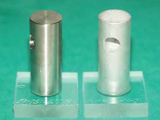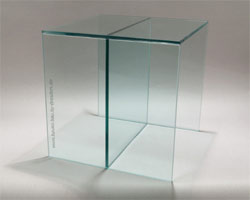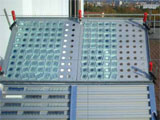During bonding of float glass, the atmospheric glass side showed increased strength values vs. the bath side – both when determining the initial strength values and after water storage. Consequently, in all experiments, bonding was carried out on the atmospheric side of the float glass.
Acrylate adhesives with lower Young’s modulus were chosen for linearly bonded joints. Adhesives with higher Young’s modulus were used for point-wise bonding. Having analyzed the bonding strength as function of the adhesive layer thickness, the optimum was detected at 0,2 mm thickness. In surface pre-processing of glass, the Pyrosil method (pyrolitic dispersion of silicone oxide, a kind of silication) provided the best results, whereas, in pre-processing of metal, the SACO technique (sandblast coating) supplied the best values.
For ageing of the bonded joints, assuming an interior application, the following tests were conducted: water storage, UV irradiations, SUN test, cleaning agent test, and climatic condition change. With material combinations intended for bonded exterior applications, a salt spray test and SO2 test were added. The photo-initiated curing acrylates were mainly sensitive to standing water and cleaning agent influence. At temperatures of 80 °C, a strong decrease in strength became obvious, whereas, due to the added stabilizers, a UV or even storage under changing climatic conditions rarely resulted in decreasing strength. Long-term ageing confirmed the results obtained in the accelerated tests.
The experiments proved that the acrylates described are suitable adhesives for architectural glazing, if the following conditions are maintained: persistent humidity is avoided, a flexible mounting is used, unforced mounting of the glass pane is planned, and a sufficiently large bonding area can be expected.
In addition to the measures described, glass-plastic bonded joints for civil engineering were investigated with partners in a project of the German Research Foundation (DFG).
 Fraunhofer Institute for Material and Beam Technology IWS
Fraunhofer Institute for Material and Beam Technology IWS

